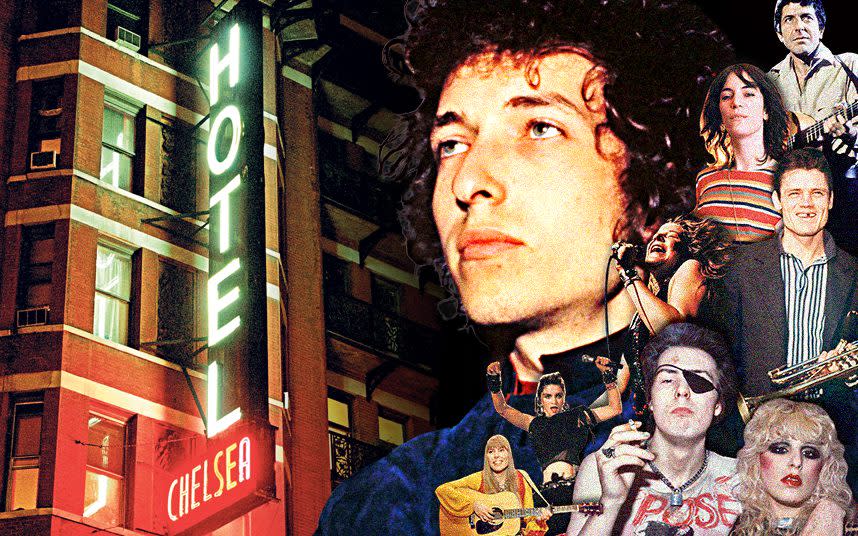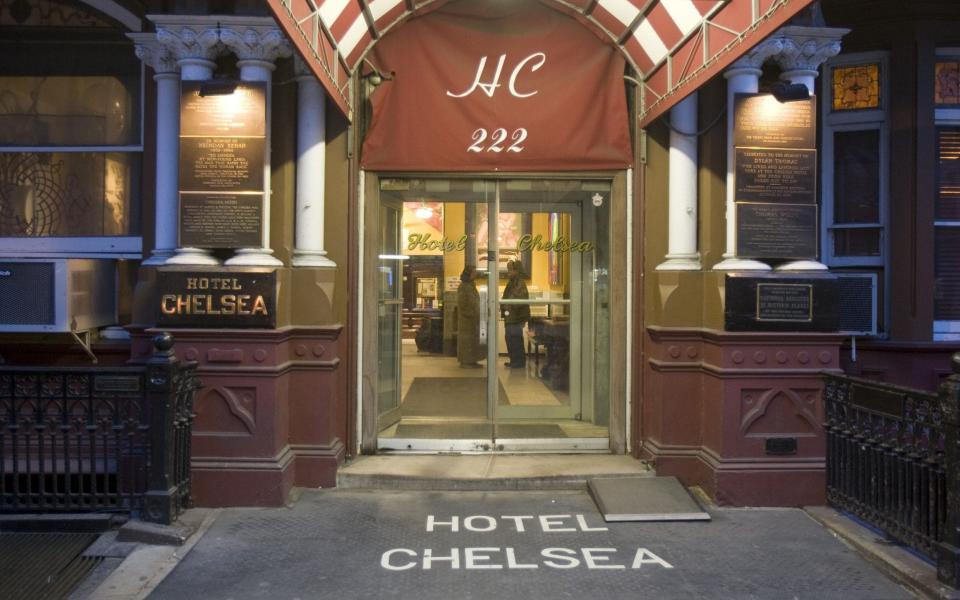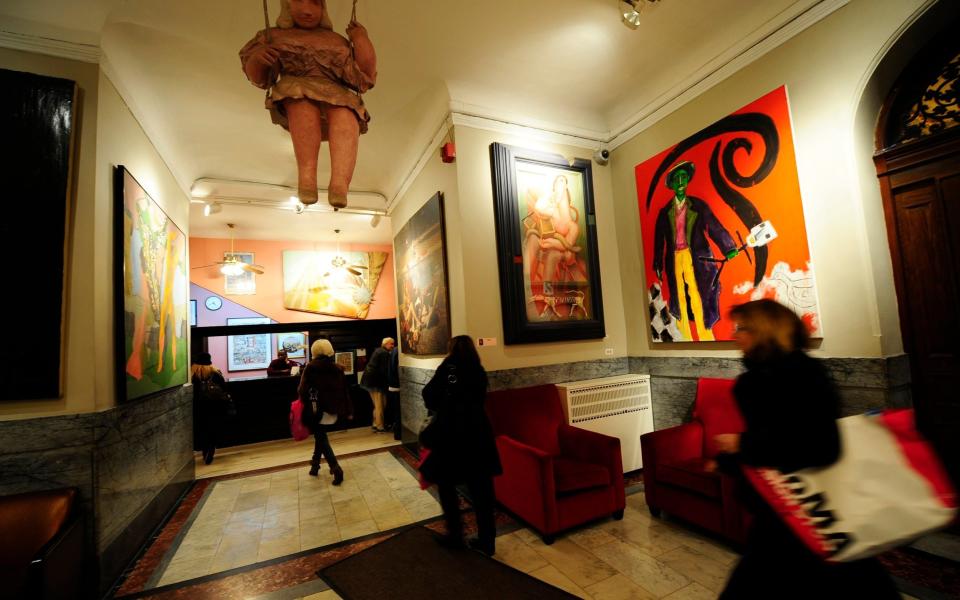Inside the Chelsea Hotel, New York’s infamous house of pleasure and pain

Leaving aside for one moment the allegations levelled this week at Bob Dylan, who is accused of grooming and sexually assaulting a 12-year-old girl at New York’s Chelsea Hotel in 1965, probably the most famous incident committed in the establishment was immortalised by Leonard Cohen in his song Chelsea Hotel #2 – and surely the most famous celebration in song of a hotel ever – in which he describes being pleasured by the singer Janis Joplin: “I remember you well in the Chelsea Hotel, you were talking so brave and so sweet …”
The allegations against Dylan are particularly shocking. A lawsuit filed in New York alleges that over a six-week period, the singer “befriended and established an emotional connection” with the plaintiff, identified only as JC, now a 68-year-old woman living in Connecticut, exploiting his position as a musician to gain her trust, and “lower[ing] JC’s inhibitions with the object of sexually abusing her, which he did, coupled with the provision of drugs, alcohol and threats of physical violence, leaving her emotionally scarred and psychologically damaged to this day.”
Dylan’s representative has denied the allegations, saying: “This 56-year-old claim is untrue and will be vigorously defended.”
What is indisputable is that in its long and storied history, the Hotel Chelsea, to give it its proper name, witnessed an abundance of pleasure, a surfeit of pain, a fair share of deviance, and more than its fair share of genius. Alcoholic writers, suicidal artists, Trotskyites, drag queens, bohemian eccentrics and all manner of waifs and strays – the Chelsea long enjoyed a rackety reputation for happily throwing open its doors to people who would have been thrown out anywhere else, and turning a blind eye to whatever they might have got up to, in a way that would be more than frowned on today.
The Chelsea was built in 1884 as “a cooperative club” by architect and developer Philip Hubert, inspired by the utopian ideas of the French philosopher Charles Fourier for an “urban phalanstery”, where people of “congenial tastes” would live harmoniously, sharing intellectual and creative interests and enjoying unfettered sexuality. The last, at least, would become an enduring characteristic of life at the Chelsea.

The building originally comprised 80 flats, occupied by artists, writers, government officials and wealthy widows, but in 1905, after going into bankruptcy, the Chelsea became a residential hotel, and was subdivided into more than 300 rooms and suites. Mark Twain was a regular visitor. Following the Second World War it went into decline and prices fell, attracting a singular mixture of penurious writers, artists and eccentrics. From its earliest days, the Chelsea attracted literary and theatrical figures. Mark Twain and O Henry stayed there; so did Sarah Bernhardt and the artist Frida Kahlo. Mark Rothko used the old dining room as a studio.
Jackson Pollock signalled his disdain for the art establishment by vomiting on the carpet of the private dining room where Peggy Guggenheim was trying to introduce important collectors to his work. Her sister Hazel had the presence of mind to advise the restaurant manager to frame the vomit-stained carpet on the grounds that it would one day be worth millions. Vomit was not uncommon at the Chelsea. The accommodation was far from luxurious. The corridors were once described as having “the charm of a Soviet-era mental ward”, while the Russian poet Yevgeny Yevtushenko described his room as having “a smell of Dachau”.
“This hotel does not belong to America,” the playwright Arthur Miller, who lived in room 614 for six years following his divorce from Marilyn Monroe, once wrote. “There are no vacuum cleaners, no rules and no shame.” The decor, he observed, leaned less towards “grand hotel” than “Guatemalan maybe, or outer Queens”.
But the Chelsea had something that no amount of money or interior decoration could buy: a singular style and a unique legend.
It was a place where literary history was made. In November 1953 the Welsh poet Dylan Thomas collapsed into a coma in his room, following a monumental bender at the nearby White Horse Inn – “I’ve had 18 straight whiskies. I think that’s the record,” he said, after polishing off a bottle of Old Grandad – before being carted off to hospital to die. Charles R Jackson, the author of The Lost Weekend, committed suicide there in September 1968. On a happier note, Jack Kerouac and Gore Vidal retired to Kerouac’s room following a Greenwich Village bar crawl, resolving that “we owed it to literary history to couple”. Allen Ginsberg also lived at the Chelsea, and in the Eighties and Nineties it became almost a retirement home for ageing beats including the poets Gregory Corso and Herbert Huncke.
Patti Smith lived there with the photographer Robert Mapplethorpe in her Just Kids period. The jazz trumpeter Chet Baker nursed his heroin addiction there in the Eighties, around the time Madonna was also living in the hotel. She returned there in 1992 to shoot the photographs for her book Sex in room 822.
For more than 50 years the hotel was managed by a man named Stanley Bard. A sort of bohemian Medici, Bard would often accept paintings in lieu of rent (a shrewd move in the case of Rothko and Larry Rivers), which decorated the lobby and corridors. Bard displayed a high threshold of tolerance to quirks and enthusiasms. George Kleinsinger, the American composer best known for the children’s composition Tubby the Tuba, shared his apartment with a monkey, a 5ft iguana, a 12ft python, a pet alligator, and his twentysomething girlfriend (Kleinsinger was in his seventies).
“It maintained a very high standard of eccentricity, but it could get you down,” says Anthony Wall, who produced an Arena film for the BBC on the hotel in 1981, and spent several months living there. “I remember a cockroach the size of a rhinoceros beetle that sat on the floor in my room for three days just looking at me.”

The Chelsea was not, in the strictest sense of the term, a rock and roll hotel, while musicians and rock and rollers often stayed there – most infamously the Sex Pistol, Sid Vicious, who in 1978 was charged with stabbing his girlfriend Nancy Spungen to death in room 100. Vicious died of a heroin overdose before the case came to trial. Bard wisely subdivided the first floor suite where the killing occurred to prevent the room becoming a shrine.
Vicious notwithstanding, the epicentre of rock and roll debauchery was the Hyatt House in Los Angeles, a favourite of touring musicians in the Seventies which became infamous as the “riot house”. At Rodney Bingenheimer’s English Disco, a short stroll away from the Hyatt on Sunset Strip – with its unspoken rule that “if you’re 18 you’re over the hill” – under-age groupies flocked around visiting British bands. Like so much that went on in the Sixties and Seventies, it is no defence to say that everybody knew – but everybody knew. Rechristened as the Andaz, the Hyatt House, it should be said, now enjoys an unimpeachable reputation.
Dylan lived at the Chelsea for a period in 1964, staying in room 211, while he was courting Sara Lownds, writing songs for the album Blonde on Blonde, and later memorialising his time there in the song Sara, in the line “stayin’ up for days in the Chelsea hotel, writin’ Sad-Eyed Lady of the Lowlands for you.” They married in November 1965.
The alleged offences are said to have taken place over the course of six weeks in April and May that year. Dylan was probably one of the most closely scrutinised people in the Western world at the time, and social media has been filled with details of his movements during the period in question. In early April he was performing concerts in Los Angeles, Oregon and Canada. From April 27 to mid-May he was touring in Britain, followed by a break in Portugal before being admitted to hospital back in Britain with a viral infection.
Whatever the truth of the allegations, the Chelsea of Bob Dylan, Allen Ginsberg, Sid Vicious, George Kleinsinger and his 12ft python are long gone. In 2011 the hotel was sold to real estate developer Joseph Chetrit for $80 million (£60 million). The artworks were taken off the walls and what passed for normal life among the residents was rudely halted – among them a self-styled “party organiser” named Palagia, described as “a 37-year-old Greek Madonna lookalike” who was banned from throwing her monthly sex parties, which she had been staging for the past 11 years, “due to liability”. The hotel has changed hands twice since then, and is now undergoing renovation. In 2018, 50 doors from the hotel, salvaged after the 2011 sale, were put up for auction. The door of room 424, where Janis Joplin and Leonard Cohen disported themselves, as Cohen’s song had it, “on the unmade bed”, and where Joni Mitchell also once stayed, fetched $85,000. The door to Jack Kerouac’s room sold for $30,000, and to Dylan’s for $100,000. If doors could talk...


